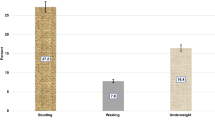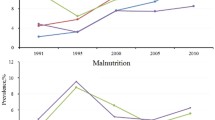Abstract
Background/objectives
Vietnam is undergoing a nutrition transition, which is leading to marked shifts in body size at the population level, but up-to-date data are lacking. We therefore quantified the prevalence of undernutrition (stunting and thinness) and overnutrition (overweight, obesity, and abdominal obesity) in school-aged children in Ho Chi Minh City (HCMc), Vietnam, and compared this with previous estimates.
Subjects/methods
A cross-sectional survey of 10,949 children (6–18 years old) from 30 schools in HCMc, Vietnam in 2014–2015 was used to ascertain the nutritional status of children and adolescents. Different international classification systems (WHO, IOTF, IOTF for Asian children) were used to assess the prevalence of under and overnutrition. Comparisons were made with previous surveys in HCMc.
Results
Regardless of definitions used, the prevalence of overnutrition was high, particularly in primary school children (20–30% were overweight, 20–30% were obese, and 50% had abdominal obesity), in boys, and urban children. Undernutrition was more prevalent in high-school children (8% were stunted, and 6–18% were thin, versus 2 and 2–9% in primary children, respectively), and in rural areas. Comparisons with previous surveys indicated substantial increases in overnutrition and decreased in undernutrition since 2009 in all age groups.
Conclusions
Overnutrition is increasingly common in school-aged children and adolescents in HCMc, while over and undernutrition continue to coexist. These findings highlight an urgent need for greater efforts to control malnutrition in children in HCMc.


Similar content being viewed by others
References
Prendergast AJ, Humphrey JH. The stunting syndrome in developing countries. Paediatr Int Child Health. 2014;34:250–65.
Gupta N, Goel K, Shah P, Misra A. Childhood obesity in developing countries: epidemiology, determinants, and prevention. Endocr Rev. 2012;33:48. https://doi.org/10.1210/er.2010-0028.
Popkin BM. Global nutrition dynamics: the world is shifting rapidly toward a diet linked with noncommunicable diseases. Am J Clin Nutr. 2006;84:289–98.
NCD Risk Factor Collaboration (NCD-RisC). Worldwide trends in body-mass index, underweight, overweight, and obesity from 1975 to 2016: a pooled analysis of 2416 population-based measurement studies in 128.9 million children, adolescents, and adults. Lancet. 2017;390:2627–42. https://doi.org/10.1016/S0140-6736(17)32129-3.
Department of Health (editor). National Nutrition Strategy for 2011–2020, with a vision toward 2030. Hanoi: Medical Publishing House; 2012.
Song S, Song WO. National nutrition surveys in Asian countries: surveillance and monitoring efforts to improve global health. Asia Pac J Clin Nutr. 2014;23:514–23.
Le Nguyen BK, Le Thi H, Nguyen Do VA, Tran Thuy N, Nguyen Huu C, Thanh Do T, et al. Double burden of undernutrition and overnutrition in Vietnam in 2011: results of the entirely study in 0.5-11-year-old children. Br J Nutr. 2013;110:S45–56. https://doi.org/10.1017/s0007114513002080.
Vietnam General Statistics Office. Statistical data. Ha Noi; 2017. https://www.gso.gov.vn/default_en.aspx?tabid=780. Accessed 4 Apr 2019.
Ho Chi Minh Statistics Office. Ho Chi Minh City statistical yearbook 2017. Ho Chi Minh City: Thanh Nien Publishing; 2018.
Vietnam General Statistics Office. Statistical summary book of Vietnam 2017. Vietnam: Stattistical Publising House; 2017.
Tran TMH, Vu QH, Do TND. Trends in nutritional status and growth of school students in Hochiminh city during 2002 to 2009. J Food Nutr Sci. 2012;8:17–26.
WHO. Appropriate body-mass index for Asian populations and its implications for policy and intervention strategies. Lancet. 2004;363:157–63.
Sung RY, Yu CC, Choi KC, McManus A, Li AM, Xu SL, et al. Waist circumference and body mass index in Chinese children: cutoff values for predicting cardiovascular risk factors. Int J Obes. 2007;31:550–8. https://doi.org/10.1038/sj.ijo.0803452.
Word Health Organization. WHO child growth standards: training course on child growth assessment. Geneva: WHO; 2008.
de Onis M, Onyango AW, Borghi E, Siyam A, Nishida C, Siekmann J. Development of a WHO growth reference for school-aged children and adolescents. Bull World Health Organ. 2007;85:660–7.
Cole TJ, Bellizzi MC, Flegal KM, Dietz WH. Establishing a standard definition for child overweight and obesity worldwide: international survey. Br Med J. 2000;320:1240–3.
Rolland-Cachera MF. Towards a simplified definition of childhood obesity? A focus on the extended IOTF references. Pediatr Obes. 2012;7:259–60.
Sung RY, So HK, Choi KC, Nelson EA, Li AM, Yin JA, et al. Waist circumference and waist-to-height ratio of Hong Kong Chinese children. BMC Public Health. 2008;8:324. https://doi.org/10.1186/1471-2458-8-324.
Cook S, Weitzman M, Auinger P, Nguyen M, Dietz WH. Prevalence of a metabolic syndrome phenotype in adolescents: findings from the third National Health and Nutrition Examination Survey, 1988-1994. Arch Pediatr Adolesc Med. 2003;157:821–7. https://doi.org/10.1001/archpedi.157.8.821.
Rojroongwasinkul N, Kijboonchoo K, Wimonpeerapattana W, Purttiponthanee S, Yamborisut U, Boonpraderm A, et al. SEANUTS: the nutritional status and dietary intakes of 0.5-12-year-old Thai children. Br J Nutr. 2013;110:S36–44. https://doi.org/10.1017/s0007114513002110.
Sandjaja S, Budiman B, Harahap H, Ernawati F, Soekatri M, Widodo Y, et al. Food consumption and nutritional and biochemical status of 0.5-12-year-old Indonesian children: the SEANUTS study. Br J Nutr. 2013;110:S11–20. https://doi.org/10.1017/s0007114513002109.
Chew WF, Leong PP, Yap SF, Yasmin AM, Choo KB, Low GK, et al. Risk factors associated with abdominal obesity in suburban adolescents from a Malaysian district. Singap Med J. 2017. https://doi.org/10.11622/smedj.2017013.
Duncan JS, Duncan EK, Schofield G. Accuracy of body mass index (BMI) thresholds for predicting excess body fat in girls from five ethnicities. Asia Pac J Clin Nutr. 2009;18:404–11.
Albrecht SS, Gordon-Larsen P. Ethnic differences in body mass index trajectories from adolescence to adulthood: a focus on Hispanic and Asian subgroups in the United States. PLoS ONE. 2013;8:e72983. https://doi.org/10.1371/journal.pone.0072983.
Jia P, Xue H, Zhang J, Wang Y. Time trend and demographic and geographic disparities in childhood obesity prevalence in china-evidence from twenty years of longitudinal data. Int J Environ Res Public Health. 2017. https://doi.org/10.3390/ijerph14040369.
Prentice AM, Ward KA, Goldberg GR, Jarjou LM, Moore SE, Fulford AJ, et al. Critical windows for nutritional interventions against stunting. Am J Clin Nutr. 2013;97:911–8.
WHO. Double-duty actions. Policy brief. Geneva: World Health Organization; 2017.
Do LM, Tran TK, Eriksson B, Petzold M, Nguyen CT, Ascher H. Preschool overweight and obesity in urban and rural Vietnam: differences in prevalence and associated factors. Glob Health Action. 2015;8:28615. https://doi.org/10.3402/gha.v8.28615.
Sano A, Le DS, Tran MH, Pham HT, Kaneda M, Murai E, et al. Study on factors of body image in Japanese and Vietnamese adolescents. J Nutr Sci Vitaminol. 2008;54:169–75.
Ho Chi Minh Statistics Office. Living standard and social security. In: General Division of the City Statistical Office (editor). Ho Chi Minh City statistical yearbook 2015. Ho Chi Minh City: Statistical Publishing House; 2016. p. 324.
Hoang TX, Truong AT, Luu QT, Dinh GT, Dinh PTT. Food sercurity in the context of Vietnam’s rural-urban linkages and climate change. London: IIED; 2013.
Baker P, Friel S. Processed foods and the nutrition transition: evidence from Asia. Obes Rev. 2014;15:564–77. https://doi.org/10.1111/obr.12174.
Vuong TN, Gallegos D, Ramsey R. Household food insecurity, diet, and weight status in a disadvantaged district of Ho Chi Minh City, Vietnam: a cross-sectional study. BMC Public Health. 2015;15:232. https://doi.org/10.1186/s12889-015-1566-z.
Lachat C, Khanh le NB, Khan NC, Dung NQ, Nguyen do VA, Roberfroid D, et al. Eating out of home in Vietnamese adolescents: socioeconomic factors and dietary associations. Am J Clin Nutr. 2009;90:1648–55. https://doi.org/10.3945/ajcn.2009.28371.
To QG, Gallegos D, Do DV, Tran HTM, To KG, Wharton L, et al. The level and pattern of physical activity among fifth-grade students in Ho Chi Minh City, Vietnam. Public Health. 2018;160:18–25. https://doi.org/10.1016/j.puhe.2018.03.021.
General Statistics Office, Fund UNP. The 2014 Vietnam intercensal population and housing survey: Population sex-age structure and related socio-economic issues in Vietnam. Ha Noi: Vietnam News Agency Publishing House; 2016.
Bell BA, Ferron JM, Kromrey JD. Cluster size in multilevel models: the impact of sparse data structures on point and interval estimates in two-level models. JSM Proc Sect Surv Res Methods; 2008. p. 1122–9.
Ngan HTD, Tuyen LD, Phu PV, Nambiar S. Childhood overweight and obesity amongst primary school children in Hai Phong City, Vietnam. Asia Pac J Clin Nutr. 2018;27:399–405. https://doi.org/10.6133/apjcn.062017.08.
Butte NF, Garza C, de Onis M. Evaluation of the feasibility of international growth standards for school-aged children and adolescents. J Nutr. 2007;137:153–7.
Liu A, Byrne NM, Kagawa M, Ma G, Poh BK, Ismail MN, et al. Ethnic differences in the relationship between body mass index and percentage body fat among Asian children from different backgrounds. Br J Nutr. 2011;106:1390–7. https://doi.org/10.1017/s0007114511001681.
Acknowledgements
The Survey of Nutritional Status among school-aged children in primary, secondary, and high schools in Ho Chi Minh City, Vietnam was conducted under the funding scheme from the Department of Health and the Department of Science and Technology in Ho Chi Minh City, Vietnam. We would like to thank Ho Chi Minh City Nutrition Center for the permission of using data from this survey.
Funding
This work was supported by Australia Awards Scholarship (TMTM, scholarship number AAS1506748); National Health and Medical Research Council of Australia (SJJ, fellowship number APP1061341).
Author information
Authors and Affiliations
Contributions
MTMT analyzed data, interpreted results, generated tables of results, and wrote the first draft of the paper, PNO collected data, TTMH designed the survey and collected data, DTND and GD interpreted results. MTMT, JSJ, vdPJC and BP contributed to the analysis plan. All authors contributed to the interpretation of results and writing of the paper.
Corresponding author
Ethics declarations
Conflict of interest
The authors declare that they have no conflict of interest.
Ethical approval
This study was conducted according to the guidelines laid down in the Declaration of Helsinki, and all procedures involving human subjects were approved by the Ethics Committee of Ho Chi Minh City Nutrition Center. Written informed consents were obtained from all subjects. The secondary analysis was approved by the School of Public Health Ethics Committee, The University of Queensland (TM20122016).
Additional information
Publisher’s note Springer Nature remains neutral with regard to jurisdictional claims in published maps and institutional affiliations.
Supplementary information
Rights and permissions
About this article
Cite this article
Mai, T.M.T., Pham, N.O., Tran, T.M.H. et al. The double burden of malnutrition in Vietnamese school-aged children and adolescents: a rapid shift over a decade in Ho Chi Minh City. Eur J Clin Nutr 74, 1448–1456 (2020). https://doi.org/10.1038/s41430-020-0587-6
Received:
Revised:
Accepted:
Published:
Issue Date:
DOI: https://doi.org/10.1038/s41430-020-0587-6
- Springer Nature Limited
This article is cited by
-
Prevalence, determinants, intervention strategies and current gaps in addressing childhood malnutrition in Vietnam: a systematic review
BMC Public Health (2024)
-
Lifetime impact of being underweight or overweight/obese during childhood in Vietnam
BMC Public Health (2022)
-
Key Informants’ Perspectives on Childhood Obesity in Vietnam: A Qualitative Study
Maternal and Child Health Journal (2022)
-
Tensions and coalitions: A new trade agreement affects the policy space for nutrition in Vietnam
Food Security (2022)
-
Early childhood factors associated with obesity at age 8 in Vietnamese children: The Young Lives Cohort Study
BMC Public Health (2021)




